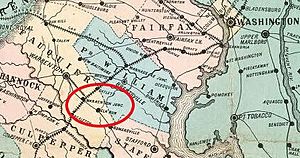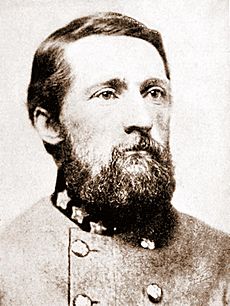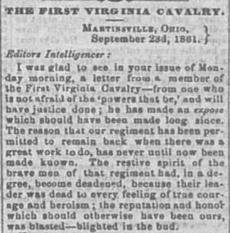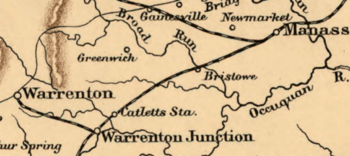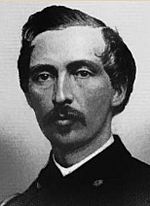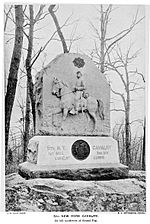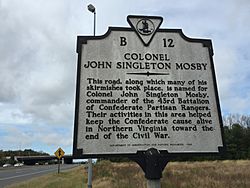Warrenton Junction Raid facts for kids
Quick facts for kids Warrenton Junction Raid |
|||||||
|---|---|---|---|---|---|---|---|
| Part of the American Civil War | |||||||
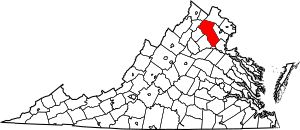 Fauquier County in Virginia |
|||||||
|
|||||||
| Belligerents | |||||||
| Commanders and leaders | |||||||
| Maj. Josiah Steele 1WVA Maj. John Hammond 5NY |
Maj. John S. Mosby | ||||||
| Units involved | |||||||
| 1st WV Cavalry (det.) 5th NY Cavalry (det.) |
Mosby's Rangers | ||||||
| Strength | |||||||
| 1WVA 100, 5NY 40+ | 70-125 | ||||||
| Casualties and losses | |||||||
| ~19 | ~30 | ||||||
| Mosby surprised 1st (West) Virginia, then 5th New York surprised Mosby | |||||||
The Warrenton Junction Raid happened on May 3, 1863, during the American Civil War. It was a surprise attack by Confederate guerrilla fighters. They attacked a group of Union cavalry soldiers.
The raid took place near a railroad crossing in Virginia's Fauquier County. This spot was less than 10 miles from the town of Warrenton. Confederate Major John S. Mosby led the attack. He targeted about 100 men from the Union's 1st (West) Virginia Cavalry.
At first, Mosby's attack was very successful. Many Union soldiers quickly surrendered to the Confederates. The rest of the Union force was surrounded in a house. Two of their leaders were wounded. When the house was set on fire, the remaining Union soldiers also gave up.
As Mosby's men gathered prisoners and horses, a group from the 5th New York Cavalry arrived. They surprised Mosby's fighters and rescued most of the captured Union soldiers. After a short fight, more Union soldiers joined the chase. These were from the 5th New York and the 1st Vermont Cavalry. They pursued Mosby's fleeing men.
The 1st (West) Virginia Cavalry, who were first surprised, lost 16 men. Mosby had to let most of his prisoners go while escaping. But he still managed to keep at least two West Virginians. Mosby's side lost 1 killed and at least 30 taken prisoner. Many of these prisoners were wounded. The 5th New York Cavalry had three men wounded.
Both sides in this small fight became very skilled later in the war. The Union's 1st Virginia Cavalry became one of West Virginia's best regiments. It had 14 soldiers who received the Medal of Honor. This unit fought at the Battle of Gettysburg. It also helped defeat the Confederate Army of the Valley. The regiment was present when General Robert E. Lee surrendered his Army of Northern Virginia.
The Confederacy's Mosby's Rangers suffered their first defeat here. However, they became experts at guerrilla warfare. They were a constant problem for Union armies in eastern Virginia.
Contents
Why the Raid Happened
By May 1863, the American Civil War was in its third year. The war started when southern states, like Virginia, left the United States. They formed a new country called the Confederate States of America. The U.S. government did not agree with this and fought to end the rebellion.
The people of Virginia were very divided. Many in the western part of the state wanted to stay with the United States. They did not want to join the Confederacy.
Fauquier County's Role
Fauquier County, Virginia, is about 50 miles west of Washington, D.C.. It is also about 100 miles northwest of Richmond, Virginia. Richmond was the capital of the Confederate States of America.
In 1860, the county had 21,763 people. About half of them were enslaved. Because of its location and a railroad, soldiers from both sides were often in the area. Several battles happened in the county.
The Orange and Alexandria Railroad ran through Fauquier County. This railroad was very important. It was the only rail link between Washington and Richmond. It also connected to other key areas like the Shenandoah Valley and lead mines. Lead from these mines was used to make bullets for the Confederate Army.
The town of Warrenton was the main town in Fauquier County. A branch line connected Warrenton to the main Orange and Alexandria Railroad. This helped the town grow. Farmers could easily sell their crops and livestock.
Mosby's Rangers: Guerrilla Fighters
In early 1863, Confederate generals Robert E. Lee and Jeb Stuart gave John Singleton Mosby permission to lead a small group. This group of 15 partisan rangers would operate behind enemy lines in northern Virginia. Mosby had been one of Stuart's best scouts. His new cavalry unit became known as Mosby's Rangers.
Mosby said his unit's goal was not to win big battles. Instead, he wanted to "compel the enemy either greatly to contract his lines or to reinforce them." This meant forcing the Union army to spread out or bring in more soldiers. He achieved this by making "incessant attacks," day or night, when the enemy was not ready.
Mosby's Rangers made quick strikes and then disappeared. Mosby copied his fighting style from General Francis Marion of the American Revolutionary War. Marion learned from the Cherokee Indians. Mosby's Rangers had no main camp. They usually scattered among local farmhouses, especially in Fauquier and Loudoun Counties.
Mosby's favorite weapon was the Colt 6-shot revolver. Each of his men usually carried two or more revolvers. They would not shoot until their target was very close, within 30 feet. Mosby did not like sabers. Union cavalry often tried to get close enough to use their sabers. This helped Mosby's men get their enemies within revolver range.
Mosby's Rangers mostly operated in an area around Warrenton. This area became known as Mosby's Confederacy. Even though they were new, Mosby's Rangers had already had successful raids. He even captured Union General Edwin H. Stoughton while he was asleep. After this raid, Mosby became one of the most famous soldiers in America. His unit grew and became the 43rd Battalion, Virginia Cavalry.
On May 2, Mosby gathered 70 to 100 men. Their goal was to attack the supply wagons of Union General Joseph Hooker's army. They spent the night in Warrenton. At dawn, they headed towards Fredericksburg. They planned to attack Hooker's wagons as they crossed the Rappahannock River.
Between 8:00 and 9:00 AM, near Warrenton Junction, they accidentally found the 1st (West) Virginia Cavalry.
The 1st (West) Virginia Cavalry
In May 1863, there were two 1st Virginia Cavalries. One fought for the Confederacy. The other, the 1st Virginia Cavalry, stayed loyal to the Union. This loyal unit was often called the "union" or "loyal" 1st Virginia. Later, it was called "West" Virginia. On June 20, the new state of West Virginia joined the Union. The loyal 1st Virginia Cavalry officially became the 1st West Virginia Cavalry.
The 1st West Virginia Cavalry became one of the most active and effective regiments by the end of the war. It had 14 Medal of Honor winners. However, it took years for them to become a strong military unit. Early reports in 1862 said the regiment was "good for nothing."
On May 3, 1863, about 100 men from this unit were near Warrenton Junction. This was less than 60 miles west of Washington, D.C. They had finished their morning mission. Their horses were unsaddled and eating. The Union soldiers had not taken many steps to protect themselves.
Major Josiah Steele was the highest-ranking officer present. The detachment included men from Companies C, F, G, and L. Captain William Harris led Company C, and Captain William McCoy led Company F.
The Attack Begins
Mosby's men came out of the woods near Warrenton Junction. They saw the 1st (West) Virginia Cavalry about 300 yards away in an open field. When Mosby's men approached, the Union soldiers thought they were friendly troops from the 1st Vermont Cavalry. Mosby ordered a charge, and his men let out a "yell".
The surprised 1st (West) Virginia Cavalry soldiers ran for their weapons. They tried to find cover in three nearby buildings. A small stream slowed Mosby's men just enough. All but about 20 of the Union soldiers reached cover. The 20 men who were too far from buildings were quickly captured.
Major Josiah Steele saw that he could not saddle the horses in time. He cut the horses loose to prevent them from being captured. The men who hid in the two smallest buildings soon realized they had little protection. They quickly surrendered. Many Union soldiers took cover in the largest building, near the railroad tracks.
Mosby's men used their revolvers to attack the crowded building. Both sides fought fiercely for about half an hour. Steele and Captain William A. McCoy at first refused Mosby's demand to surrender. A few of Mosby's men entered the first floor of the building. Steele and McCoy were wounded, as were many men on the first floor.
The men on the first floor surrendered. But the men on the second floor kept fighting. So, Mosby had his men set the building on fire. This forced the remaining 1st (West) Virginia Cavalry soldiers to surrender. Those who could leave the smoke-filled house exited through a blood-covered first floor. Mosby's Rangers collected prisoners and equipment. Then they started to get the horses.
The Rescue Mission
When Mosby's men attacked, many Union horses ran away. They stampeded towards the camp of 70 men from the 5th New York Cavalry. This caused some of the New Yorkers' horses to run off too.
About 40 New Yorkers, led by Major John Hammond, quickly rode to help the West Virginians. They arrived right after Mosby had gathered prisoners from the burning house.
When Hammond arrived, many of Mosby's Rangers were busy collecting horses and discarded weapons. Mosby had about 40 prisoners he was about to take back to Warrenton. This time, Mosby was the one who was unprepared. His Rangers were spread out, and he had not named a second-in-command. He did not see the New Yorkers until they were about 250 yards away.
Mosby could not gather his troops. He was forced to give up most of what he had captured as his men fled in all directions. The fight became a running battle. Union cavalry chased Mosby's Rangers. Captain Abram H. Krom of the 5th New York was shot twice but survived. He kept fighting with his saber.
Mosby suffered significant losses. He lost some of his most skilled men and 40 horses. Some Rangers escaped by crawling or hiding. The 1st Vermont Cavalry arrived after the first fighting. They joined the chase of Mosby's men. More men from the 5th New York Cavalry joined after they got their horses back.
Who Was Hurt?
The Union side had a total of 19 casualties. The 1st (West) Virginia had 2 killed and 14 wounded, including 2 officers. One officer, Major Steele, was badly wounded and later died. The 5th New York Cavalry had 3 wounded, including two officers. Mosby still managed to keep 2 prisoners from the 1st (West) Virginia.
Mosby had over 30 of his men, including several officers, taken prisoner. At least one was killed. It was also thought that some of Mosby's wounded and killed were hidden by local people. About 40 horses were also captured. About 16 of the prisoners were severely wounded. A well-known spy named Templeton was killed. Although some reports said Mosby was wounded, this was not true.
What Happened Next
Some sources believe Union leaders tried to hide how unprepared the 1st (West) Virginia Cavalry was. They reported that Mosby's lead fighters were wearing Union uniforms. Union General J.J. Abercrombie's report said Mosby's "front rank was dressed in the uniform of United States soldiers." A newspaper also said Mosby's men were mistaken for the 1st Vermont Cavalry.
Mosby agreed his men were mistaken for Union cavalry. But he wrote that his men were all dressed in Confederate gray uniforms. A Union sergeant described captured Mosby's men as having "no regularity of uniforms." He said they wore "everything they could find," with no mention of blue Union uniforms.
Better Cavalry Units
The 1st (West) Virginia Cavalry soon got better leaders and weapons. In the spring after the Mosby encounter, they received Spencer repeating rifles. These were advanced weapons. Lieutenant Colonel Nathaniel P. Richmond became their commander again. He was well-liked by his officers. In June, after West Virginia joined the Union, the unit became the 1st West Virginia Cavalry.
All three Union cavalry regiments from the Warrenton Junction Raid (5th New York, 1st Vermont, 1st West Virginia) fought together. They were part of the same brigade at the Battle of Gettysburg. Richmond proved to be a good leader. He took temporary command of the brigade at Gettysburg after its commander was killed. He led the brigade during part of the chase after the battle. During that chase, the 1st West Virginia Cavalry captured a Confederate artillery piece and a whole wagon train.
In 1865, the 1st West Virginia Cavalry was part of General Philip Sheridan's Army of the Shenandoah. This army defeated General Jubal Early's Army of the Valley at the Battle of Waynesboro, Virginia. The 1st West Virginia Cavalry helped cut off over half of Early's force, forcing them to surrender. The regiment was also ready for battle at the Battle of Appomattox Court House. But they did not fight because General Robert E. Lee's Army of Northern Virginia surrendered.
Mosby later wrote that Major Hammond was smart to attack immediately at Warrenton Junction. Hammond did not wait for the rest of his troops. This allowed the 5th New York Cavalry to catch Mosby "in disorder and scattered." Hammond became the commander of the 5th New York Cavalry on June 1, 1863. He played an important role in the Battle of Hanover on the way to Gettysburg. His regiment's historian said he was known for his "coolness and bravery." He was considered a great horseman and leader.
Mosby Learns from Mistakes
Mosby usually planned his raids carefully. He would scout and gather information. But at Warrenton Junction, he was distracted by an unexpected chance. He later wrote, "When I ordered the charge at Warrenton Junction, I had no idea whether I was attacking a hundred or a thousand men." This was a reckless move. It also stopped Mosby from reaching his original goal of attacking Hooker's supply wagons. He even wrote that "it was a mistake my making this fight, even if I had been completely successful."
Mosby also learned that leading 100 men was different from leading 15. His men came from different units. They did not have the strong teamwork and discipline that comes from being well-organized. Since he had not named any unit commanders or a second-in-command, it was hard to gather his men when they were spread out. During the fight, he also forgot to set up guards (pickets) around the area. This led to his surprise by the 5th New York Cavalry.
Mosby learned from his mistakes. Mosby's Rangers became a constant worry for Union commanders in Virginia. General Ulysses S. Grant barely escaped capture by Mosby's men. Grant decided to avoid traveling to Washington from his headquarters.
Mosby's Rangers continued to be active until the end of the war. After the war, Mosby became a Republican. He worked several jobs for the U.S. government. He died in 1916 and is buried in Warrenton.


